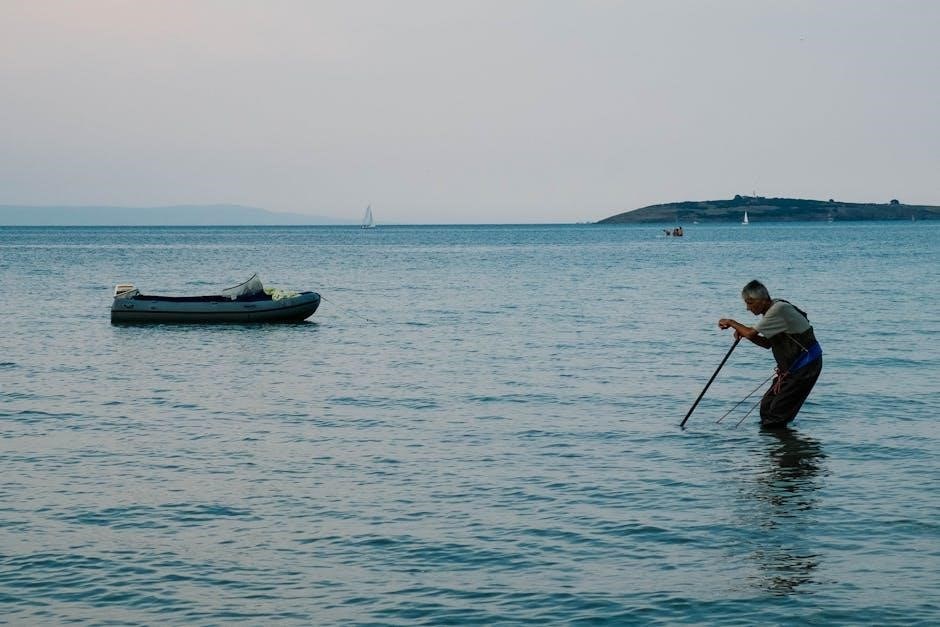summary of old man and the sea pdf

The Old Man and the Sea: A Summary
Ernest Hemingway’s “The Old Man and the Sea” tells the story of Santiago, an aging fisherman, and his long struggle to catch a giant marlin. The novella captures the authors themes of courage, resilience, and the human condition.
Plot Overview
The novella “The Old Man and the Sea” revolves around Santiago, an aging Cuban fisherman who has experienced a prolonged streak of bad luck, having gone 84 days without catching a single fish. Once a respected and skilled fisherman, Santiago now faces ridicule from some in his village. However, a young boy named Manolin remains loyal, caring for him and providing support, though he is forced by his parents to fish with a more successful crew.
Determined to reverse his fortunes, Santiago ventures far out into the Gulf Stream, beyond the usual fishing grounds. There, he hooks a massive marlin, initiating an epic battle of endurance and will. The marlin is of extraordinary size and strength, testing Santiago’s physical and mental limits. For days, the old man is pulled by the giant fish, far out to sea, battling hunger, exhaustion, and the relentless forces of nature.
Despite the immense hardship, Santiago refuses to give up, driven by his pride and a deep respect for the marlin. He sees the fish as a worthy opponent, embodying nobility and strength. After days of struggle, Santiago finally triumphs, harpooning the marlin and securing it alongside his skiff. However, his victory is short-lived, as sharks, attracted by the marlin’s blood, begin to attack the prize. Santiago fights valiantly, but is unable to prevent the sharks from devouring the marlin, leaving him with only the skeletal remains of his magnificent catch.
Santiago: The Aging Fisherman
Santiago, the protagonist of “The Old Man and the Sea,” is depicted as an aging Cuban fisherman, weathered by years of hard work and the harsh realities of life at sea. He embodies resilience and perseverance, having spent decades honing his skills and facing the unpredictable nature of the ocean. Despite his advanced age and recent streak of misfortune – going 84 days without a catch – Santiago retains an unwavering determination to prove his worth and recapture his former glory.
He is presented as a solitary figure, living a simple life in a small shack and often reflecting on his past experiences. Santiago’s humility and deep respect for the sea are evident in his thoughts and actions. He views the ocean as both a provider and a formidable adversary, recognizing the interconnectedness of all living things. His connection to nature is profound, and he often converses with the creatures of the sea, acknowledging their beauty and strength.

Despite his physical limitations, Santiago possesses a strong spirit and an unyielding sense of pride. He refuses to succumb to despair, clinging to his belief in his abilities and his determination to overcome adversity. His character embodies the theme of human endurance in the face of overwhelming odds, showcasing the power of will and the importance of maintaining dignity even in defeat. Santiago’s unwavering spirit makes him a symbol of hope and resilience, inspiring readers with his courage and determination.
Manolin’s Role and Support
Manolin plays a crucial role in “The Old Man and the Sea,” representing loyalty, companionship, and the passing of knowledge between generations. He is a young boy who deeply admires Santiago, viewing him as a mentor and father figure. Despite his parents’ disapproval, Manolin remains dedicated to the old man, providing him with essential support and companionship.
Manolin cares for Santiago, bringing him food, bait, and other necessities. His presence offers Santiago emotional support and encouragement, particularly during the old man’s extended period of bad luck. The boy’s unwavering belief in Santiago’s abilities helps to sustain the old man’s spirits and reinforces his determination to succeed. Their relationship is based on mutual respect and affection, transcending the age gap and societal expectations.
Manolin learns valuable lessons from Santiago about fishing, life, and the importance of perseverance. He absorbs the old man’s wisdom and experiences, preparing him to carry on the traditions and values of the fishing community. Manolin’s role as a caretaker and apprentice highlights the significance of mentorship and the importance of preserving cultural heritage. His unwavering support and affection for Santiago underscore the power of human connection and the enduring bond between generations.
He took care of the old mans food and his belongings.
The Epic Struggle with the Marlin
The heart of “The Old Man and the Sea” lies in Santiago’s epic struggle with the giant marlin. After eighty-four days without a catch, Santiago ventures far into the Gulf Stream, determined to break his streak of bad luck. When he finally hooks a massive marlin, the battle of wills begins, testing the old man’s physical and mental endurance to the limit. This is Santiago’s quest for a big fish.
For days, Santiago is towed by the marlin, far out into the ocean. He endures hunger, thirst, and exhaustion, but refuses to relinquish his hold on the line. The marlin, a creature of immense power and beauty, becomes a worthy adversary, commanding Santiago’s respect and admiration. Their struggle is not merely a contest for survival, but a profound connection between two beings bound by the laws of nature.
Santiago’s determination to land the marlin represents his unwavering spirit and his refusal to surrender to old age and misfortune. He draws strength from his memories, his love for the sea, and his respect for his opponent. The battle becomes a test of his character, revealing his courage, resilience, and his deep understanding of the natural world. It’s a story of an epic struggle between an old, seasoned fisherman and the greatest catch.
The Marlin: A Symbol of Greatness
The marlin in Hemingway’s “The Old Man and the Sea” transcends its literal existence as a fish and becomes a potent symbol of greatness, nobility, and the untamed forces of nature. The marlin’s immense size, strength, and beauty inspire awe and respect in Santiago, who sees in the creature a worthy opponent, a fellow warrior in the vast arena of the sea. The marlin represents the ultimate challenge, the pinnacle of achievement for a fisherman like Santiago.
The marlin’s unwavering spirit and its refusal to surrender, even in the face of exhaustion and pain, mirror Santiago’s own indomitable will. Both the old man and the great fish embody courage, perseverance, and a deep connection to the natural world. The marlin’s nobility is evident in its refusal to yield easily, its willingness to fight until the very end. The marlin’s capture, though a victory for Santiago, is also a tragedy, highlighting the inevitable cycle of life and death.
The marlin’s greatness lies not only in its physical attributes but also in its symbolic representation of the ideals that Hemingway admired: courage, honor, and a profound respect for the forces of nature. The marlin’s fate becomes intertwined with Santiago’s, their shared struggle elevating both to a level of symbolic significance that transcends the simple act of fishing.

Hardship and Resilience at Sea
The novella vividly depicts the immense hardship Santiago endures during his solitary journey at sea. Days turn into nights as he battles the marlin, facing exhaustion, hunger, and physical pain. The scorching sun, the biting cold of the night, and the constant strain on his body test his limits. Yet, amidst these trials, Santiago displays remarkable resilience, drawing strength from his memories, his pride, and his unwavering determination to succeed.
His calloused hands, scarred from years of fishing, become a symbol of his enduring spirit. He speaks to himself, to the marlin, and even to the birds, finding solace in the companionship of the sea. The vastness of the ocean and the isolation he experiences amplify the challenges he faces, but they also underscore his self-reliance and his deep connection to the natural world.
Santiago’s resilience is not merely about physical endurance; it is also about maintaining his dignity and his sense of self-worth in the face of adversity. Despite his age and his recent run of bad luck, he refuses to be defeated, clinging to his belief in his own abilities. His struggle becomes a testament to the human capacity to persevere, to find strength within oneself even in the most challenging circumstances.
The Return Journey and Shark Attacks
With the magnificent marlin lashed to his skiff, Santiago begins the arduous return journey to Havana. However, his triumph is short-lived as sharks, drawn by the scent of blood, begin to attack the marlin. The first shark, a Mako, is a formidable opponent, and Santiago manages to kill it with his harpoon, but not before it tears away a significant portion of the marlin’s flesh.
More sharks arrive, relentless in their pursuit of the prize. Santiago fights them off with his knife, his oar, and even the broken tiller of his boat, but each attack further diminishes the marlin. Despite his valiant efforts, he is unable to prevent the sharks from devouring the marlin, piece by piece. The once-proud fish is reduced to a skeleton, a stark reminder of the forces of nature that are beyond human control.
The shark attacks symbolize the destructive forces that can undermine even the greatest achievements. They represent the harsh realities of life, where success is often fleeting and the spoils of victory can be snatched away. Yet, even in the face of this devastating loss, Santiago refuses to give up, continuing to fight until he reaches the shore, exhausted but unbowed.
Loss and Perseverance
Santiago’s return to shore is marked by profound loss. The magnificent marlin, the symbol of his triumph, is now just a skeleton, ravaged by sharks. He arrives exhausted and defeated, dragging the remains of the fish behind him. The villagers are stunned by the sight of the enormous skeleton, a testament to Santiago’s incredible feat and devastating struggle.
Despite the loss of the marlin, Santiago’s spirit remains unbroken. He has proven his worth as a fisherman and faced the challenges of the sea with unwavering courage. His perseverance in the face of adversity highlights the enduring strength of the human spirit. Though he returns empty-handed in a literal sense, he has gained something far more valuable: a renewed sense of self-respect and the admiration of his community.
Manolin, deeply concerned for Santiago’s well-being, is there to greet him. Their bond is strengthened by the old man’s experience, and Manolin vows to continue learning from him. Santiago’s story becomes a legend, a reminder that even in defeat, there is honor and dignity to be found.

Themes: Courage and the Human Condition
“The Old Man and the Sea” explores the depths of human courage in the face of overwhelming odds. Santiago embodies resilience, refusing to surrender despite his age, physical limitations, and the relentless challenges of the sea. His unwavering determination to catch the marlin showcases the indomitable spirit that allows individuals to persevere even when faced with seemingly insurmountable obstacles.
The novella also delves into the human condition, examining themes of isolation, pride, and the interconnectedness of life. Santiago’s solitary struggle highlights the inherent loneliness of human existence, while his pride in his skills as a fisherman fuels his determination. The battle with the marlin becomes a metaphor for the human struggle against nature and the limitations of mortality.
Furthermore, Hemingway explores the delicate balance between man and nature, portraying the marlin not as a mere opponent but as a worthy adversary deserving of respect. Santiago’s admiration for the fish underscores the interconnectedness of all living things and the importance of finding dignity and honor in the face of hardship.
Symbolism in The Old Man and the Sea
Hemingway’s “The Old Man and the Sea” is rich in symbolism, adding layers of meaning to the narrative. The sea itself represents the vast and unpredictable forces of nature, a constant challenge to human endeavor. Santiago’s skiff symbolizes the frailty of human existence in the face of these powerful forces, while the marlin embodies greatness, nobility, and the ultimate prize.
The lions on the beach that Santiago dreams of represent his youthful strength and vitality, a reminder of his past glory. Manolin, the young boy, symbolizes hope, loyalty, and the continuity of life. The sharks that attack the marlin represent the destructive forces that can undermine even the most heroic achievements, highlighting the inevitability of loss and the transient nature of success.

Santiago’s suffering and endurance can also be interpreted as a Christ-like allegory, with the old man bearing the weight of his struggle and ultimately finding redemption in his perseverance. Through these symbols, Hemingway explores universal themes of life, death, and the enduring human spirit.
Literary Significance and Awards
“The Old Man and the Sea” holds a significant place in literary history, celebrated for its simple yet profound exploration of universal themes. Ernest Hemingway’s concise prose and powerful imagery create a timeless story that resonates with readers across generations. The novella’s focus on courage, resilience, and the human condition has made it a staple of literature courses worldwide.
The novel’s publication in 1952 was met with immediate acclaim, solidifying Hemingway’s reputation as a master storyteller. In 1953, “The Old Man and the Sea” was awarded the Pulitzer Prize for Fiction, recognizing its exceptional literary merit. The following year, 1954, Hemingway received the Nobel Prize in Literature, with the Nobel committee specifically citing the novella as a key factor in their decision.
The awards and accolades bestowed upon “The Old Man and the Sea” underscore its enduring impact and its contribution to the canon of great literature. It remains a testament to Hemingway’s skill in crafting a story that is both deeply personal and universally relatable.
Leave a Reply
You must be logged in to post a comment.